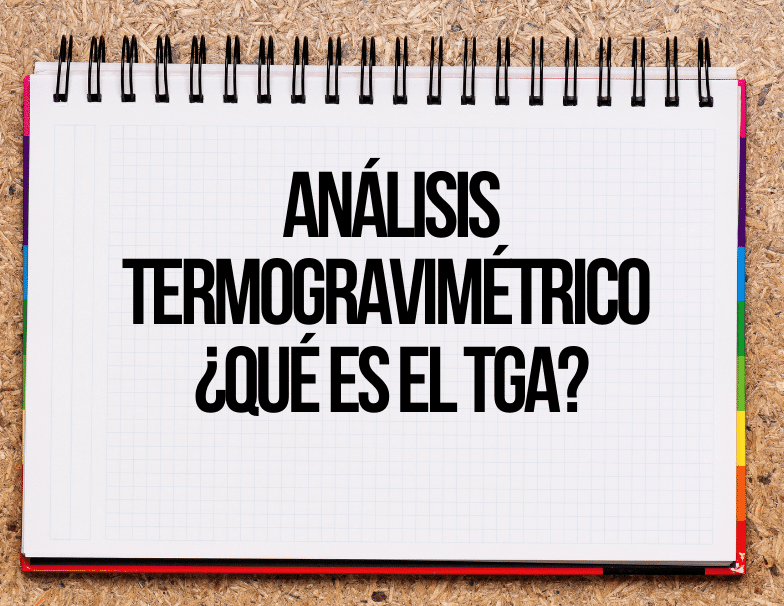TGA or thermogravimetric analysis is one of the most popular tests in the manufacturing and materials industries as it allows testing of many different materials such as metals, polymers, ceramics and glass.
Thermogravimetric analysis provides the data needed for a wide range of material characterisation purposes.
Here we explain what TGA is, how it is performed and its many industrial applications.
What is thermogravimetric analysis?
Thermogravimetric analysis (TGA) is a method of thermal analysis in which the mass of a sample is measured over time as the temperature changes or at a constant temperature for a given time. It is used to analyse the characteristics and composition of materials, decomposition and evaporation rates, oxidation, material purity and many other properties.
An example of its usefulness can be found when prospecting for new materials in order to choose the most suitable one, as was the case in the state of the art of new materials for light guides that we carried out.
TGA is a material characterisation technique used in various industries such as pharmaceutical, food, environmental or petrochemical, as it measures the composition, purity, decomposition reactions, decomposition temperature and absorbed moisture content of products.
Its main uses include measuring the thermal stability of a material, filler content in polymers, moisture and solvent content, and the percentage composition of elements in a compound. As such, it has a variety of applications in quality control and testing.
Methodology for thermogravimetric analysis
Thermogravimetric analysis consists of gradually increasing the temperature of a sample in an oven while measuring the weight on an analytical balance.
In this method, the sample is heated in a given environment (air, N2, CO2, He, Ar, etc.) at a controlled rate, and then the resulting weight loss due to semi-volatile compounds, polymer degradation, ash content, smoke blackness and moisture is calculated. Moisture and ash are also analysed.
The TGA is performed in stages. In each step, the internal temperature of the furnace is increased linearly or maintained at a constant temperature to produce a thermal reaction of the analysed substance.
During the process, the mass of the sample is continuously monitored to detect changes in the sample. Therefore, as a function of temperature or time, we can obtain and record the change in weight of the substance.
TGA analysis allows us to know the change in mass of a material as a function of time and temperature.
TGA is carried out with an instrument called a thermogravimetric analyser. This is an oven containing a sample pan supported on a precision balance.
As it heats up, this balance – which is extremely sensitive and located outside the furnace – can register the subtlest changes in the mass of the substance placed in the sample pan.
What are the types of thermogravimetric analysis (TGA)?
There are three types of thermogravimetric analysis which represent different ways of applying heat to the sample, as the change in weight is measured over time.
The three types of TGA are as follows:
- Isothermal or static thermogravimetry: The temperature remains constant.
- Dynamic thermogravimetry: The temperature changes linearly.
- Quasi-static thermogravimetry: A series of increasing temperatures is used.
Uses and applications of TGA
TGA provides accurate details of the change in mass of the materials under test.
The most common applications of thermogravimetric analysis are as follows:
Quality control and quality assurance
By testing a product’s resistance to heat and temperature fluctuations, as well as identifying the points at which it decomposes or evaporates, a thermogravimetric analysis can determine whether a product meets industry standard quality and stability parameters for safe use. An example of this can be seen in the use of TGA analysis for quality control and defect detection in electrical cables that we carry out at INFINITIA Industrial Consulting.
Determination of thermal stability
Similarly, thermogravimetric analysis can be used to subject a material – plastic polymer, gas, adhesive, etc. – to the temperature range in which it will have to operate while in use, in order to ensure that the product meets expectations during its normal application. As in the case of defect detection and quality control of thermoplastic components to identify the failure.
The most common application of TGA in the industrial field is the testing of the thermal resistance of products.
Oxidation and combustion of materials
Oxidation reactions are observable and measurable in thermogravimetric analysis. This is why it is frequently used, especially in products such as copper alloys, which require high resistance to oxidation.
Materials analysis by TGA
This process uses heat to force reactions and physical changes in materials, as TGA provides a quantitative measurement of the mass change in materials associated with thermal transition and degradation.
That is, it records the change in mass due to dehydration, decomposition and oxidation of a sample with time and temperature.
At INFINITIA Industrial Consulting we use TGA to determine qualitative and quantitative differences in materials, identify defects and ensure product quality, among other applications.
Do you want us to analyse your product or materials to find the best solution? Contact our Forensic Engineering team for more information.





